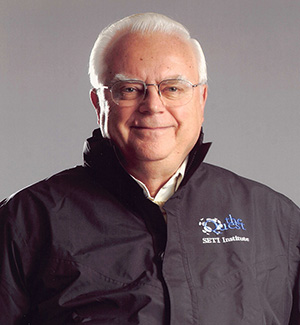Frank Drake, an eminent radio astronomer known for his pioneering efforts in the search for extraterrestrial intelligence (SETI), died September 2 at his home in Aptos, California. He was 92.
A professor emeritus of astronomy and astrophysics and former dean of natural sciences at UC Santa Cruz, Drake also served for 19 years as chair of the board of trustees of the SETI Institute, a nonprofit organization focused on research and education related to the search for life beyond Earth.
Drake's daughter Nadia Drake announced his death on her web site, where she wrote that her father “was beloved by many, and for many reasons, but above all, today I celebrate his humanity, his tenderness, his gentle spirit. A titan in life, Dad leaves a titanic absence.”
Drake is widely known for, among other things, the “Drake Equation,” which he devised in 1961 to estimate the number of communicative extraterrestrial civilizations that might be detectable in our galaxy. The equation served as an effective framework for rigorous consideration and planning of efforts to detect extraterrestrial intelligence. At the time, Drake was head of telescope operations at the National Radio Astronomy Observatory (NRAO) in Green Bank, West Virginia, where he had conducted the first organized search for radio signals from intelligent extraterrestrial sources in 1960 (Project Ozma).
Throughout his career, Drake worked to refine the methods for the detection of signals of extraterrestrial intelligence. He also shared in the discovery of the radiation belts of Jupiter and played an important role in the observational studies that led to the early understanding of pulsars (rapidly spinning neutron stars that emit beams of radiation).
First interstellar message
Drake created the first interstellar message ever transmitted deliberately into space from Earth. Known as the “Arecibo message,” it was broadcast via radio waves from the Arecibo Observatory in 1974. Drake was also involved (with Carl Sagan and others) in designing the plaques carried on the Pioneer 10 and 11 spacecraft and the “Golden Record” carried on the Voyager 1 and 2 spacecraft, with messages intended for any intelligent life the spacecraft might encounter on their journeys beyond the solar system.
Born in 1930 in Chicago, Drake earned a B.A. in engineering physics at Cornell University and M.A. and Ph.D. degrees in astronomy at Harvard University. He served as an electronics officer in the U.S. Navy from 1952 to 1955.
After working at NRAO, Drake served briefly as chief of the Lunar and Planetary Sciences Section at NASA’s Jet Propulsion Laboratory before joining the astronomy faculty at Cornell University in 1964, where he was appointed the Goldwin Smith Professor of Astronomy in 1976. He served as associate director of Cornell’s Center for Radiophysics and Space Research, and he was director of the Arecibo Observatory in Puerto Rico from 1966 to 1968. He also served as director of the National Astronomy and Ionospheric Center (which includes Arecibo Observatory) from its establishment in 1971 until 1981.
Dean of natural sciences
Drake came to UC Santa Cruz in 1984 to serve as dean of the Division of Natural Sciences, leading the division during a period of rapid growth in the campus’s science and engineering programs. He taught innovative courses in astronomy for non-science majors and mentored many undergraduate and graduate astronomy students. His wide-ranging leadership in public outreach and education in astronomy were recognized by the American Astronomical Society in 2001 with its first Education Prize.
After retiring from teaching in 1996, Drake continued to pursue his interest in the detection of extraterrestrial life, investigating radio telescope designs that optimize the chances of success for SETI and participating in projects at UC’s Lick Observatory to search for optical signals of extraterrestrial intelligence.
A member of the National Academy of Sciences and a fellow of the American Academy of Arts and Sciences, Drake served as president of the Astronomical Society of the Pacific, vice president of the American Association for the Advancement of Science, chair of the National Research Council’s Board on Physics and Astronomy, and director of the Carl Sagan Center for the Study of Life in the Universe at the SETI Institute.
Frank Drake is survived by his wife of 44 years, Amahl Shakhashiri Drake; daughters Nadia Drake (Scott Ransom), and Leila Drake Fossek (Chris Fossek); from a previous marriage, sons Steve Drake, Richard Drake (Alice Moore) and Paul Drake (Ellen Sullivan); daughters-in-law Mary and Kim; and four grandchildren. He was preceded in death by his sister Alma Quigley.



